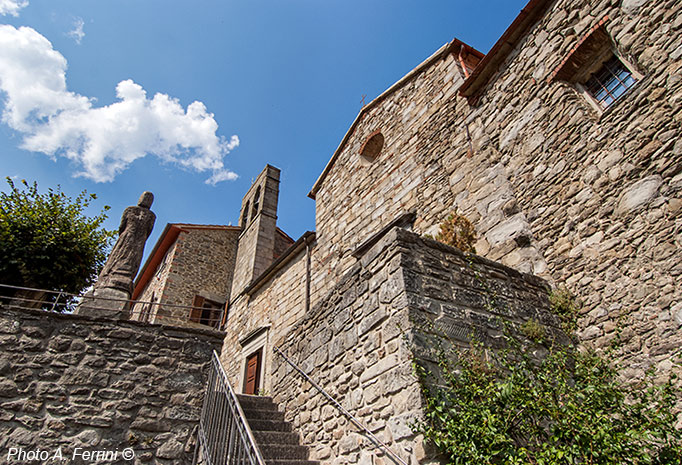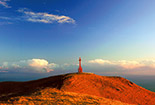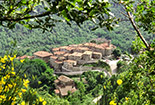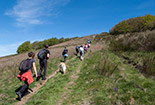Carda
in Casentino, a Tuscan valley with which you can get familiar in every detail through this site

Texts and photos by Alessandro Ferrini ©
40 immagini in sequenza di Carda accuratamente descritte. Clicca per ingrandire
Carda, a place with an important but little-known history
 Carda is a small mountain hamlet in the municipality of Castel Focognano located on the slopes of Pratomagno, at an altitude of seven hundred meters. To reach this village, once in Rassina we have to go towards Talla. After about five hundred meters turn right passing in, or next to, Pieve a Socana, a village known for its Romanesque church and a large Etruscan altar. Carda is fourteen kilometres from here. After four kilometers we will cross Castel Focognano, the ancient castle from which it takes its name to the municipality in here we are, this place is certainly worth a visit.
Carda is a small mountain hamlet in the municipality of Castel Focognano located on the slopes of Pratomagno, at an altitude of seven hundred meters. To reach this village, once in Rassina we have to go towards Talla. After about five hundred meters turn right passing in, or next to, Pieve a Socana, a village known for its Romanesque church and a large Etruscan altar. Carda is fourteen kilometres from here. After four kilometers we will cross Castel Focognano, the ancient castle from which it takes its name to the municipality in here we are, this place is certainly worth a visit.
Seen from afar the village of Carda seems to be clinging to the slopes of a mountain, in fact when we are on the spot we will realize that it is placed on a small hill on the top of which there is a small church dedicated to Saints Flora and Lucilla. This title is important because it recalls that this place in the thirteenth century was a possession of the Abbey of Arezzo whose church was, and is, dedicated to these holy martyrs. At the end of this century the place was owned by the noble and powerful family of Arezzo Ubertini to which belonged William, the famous bishop leader. For the people of Arezzo Carda was an outpost towards the Counts Guidi who were in the Castle of Raggiolo, behind the mountain in front of the village. When in the middle of the fourteenth century the Florentine Republic became the mistress of Raggiolo and the Teggina valley, it made little sense for the people of Arezzo to stay in Carda waiting to be driven out by the Florentines, so they gave this place to the monks of the nearby Badia di Santa Trinita.
A bond between the abbey and Carda began and it continued even when this place (about 1380)  became part of the Florentine dominions and was strengthened after 1425 when Santa Trinita was annexed to the Abbey of Vallombrosa, which had always been linked to Florence.
became part of the Florentine dominions and was strengthened after 1425 when Santa Trinita was annexed to the Abbey of Vallombrosa, which had always been linked to Florence.
Giving a date to the origin of Carda is not easy, the documentation is scarce or nothing. Certainly the proximity to two countries such as Raggiolo and Quota of Lombard origin can make you think the same thing for Carda. This hypothesis is reinforced by the discovery in the village of a stone (part of a ciborium), now on display in the church, on which are carved in Lombard style two peacocks who drink under a cross (symbol of immortality). This beautiful work that can be dated X century (it is in Lombard style, not Lombard era) is difficult to assume that it was brought here from another place, so it is likely to have belonged to a church before the current. The Lombard style present in the local culture necessarily leads to think of a previous settlement of this barbaric people who were well inclined to build control centers of the territory on every point they considered strategic.
Since always and until a few decades ago the population of this country has drawn sustenance from the cutting of the forest, from chestnuts, from sheep farming, from poor agriculture. Today there are few permanent residents here, but in summer the village is full, not so much of tourists, but of people who return to the home of their parents, grandparents. People who love this place, that's why Carda is well kept and tidy. The small villages are well paved and the houses have been carefully restored. For this reason it is pleasant to walk in the inner alleys of this village. It is also pleasant to walk to the stream. For lovers of trekking from Carda, there are routes that lead to the ridge of Pratomagno.
forest, from chestnuts, from sheep farming, from poor agriculture. Today there are few permanent residents here, but in summer the village is full, not so much of tourists, but of people who return to the home of their parents, grandparents. People who love this place, that's why Carda is well kept and tidy. The small villages are well paved and the houses have been carefully restored. For this reason it is pleasant to walk in the inner alleys of this village. It is also pleasant to walk to the stream. For lovers of trekking from Carda, there are routes that lead to the ridge of Pratomagno.
From the cultural point of view the most interesting thing about Carda is certainly the church, here there are imported works of art. In particular, there is a polyptych on a gold background by Mariotto di Cristofano dated 1425/26 and a Madonna and Child in glazed terracotta attributed to Santi Buglioni (about 1520). These works, and others, can be seen in the gallery of this web section.


















































